Honor Award
Ottosen Entry Garden Desert Botanical
Phoenix
Spurlock Poirier Landscape Architects, San Diego, CA
Client: Desert Botanical Garden, Phoenix
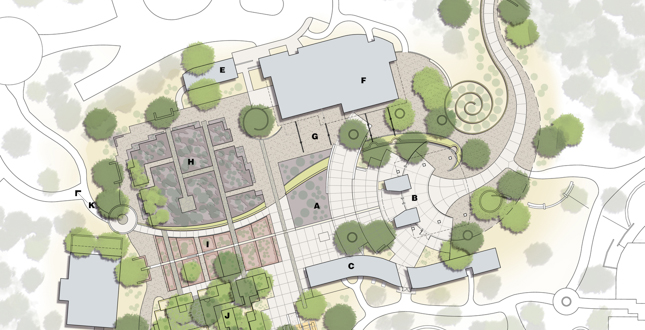
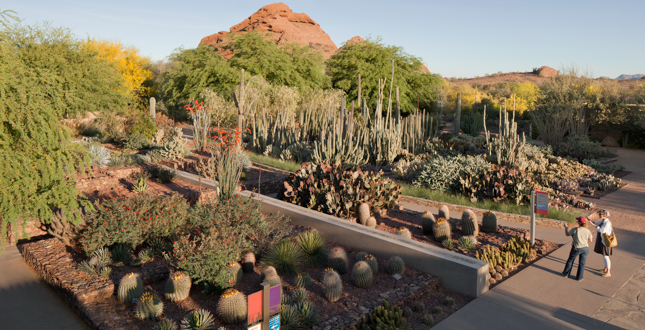 Close Me!
Close Me!A critical aspect of the redesign of the garden was to engage visitors at the entry gate. A linear light feature draws the eye into the desert landscape.
Download Hi-Res ImageImage: Bill Timmerman and Adam Rodriguez
Image 2 of 13
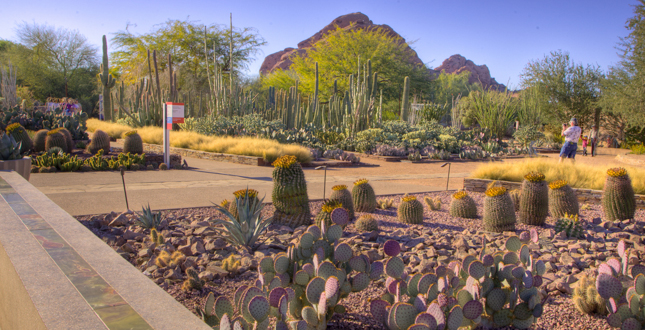 Close Me!
Close Me!A panoramic view of the garden and surrounding buttes in Papago Park orients visitors to the landscape and creates a lobby/forecourt for the botanical garden.
Download Hi-Res ImageImage: Bill Timmerman and Adam Rodriguez
Image 3 of 13
 Close Me!
Close Me!The light feature is backlit onyx and makes the connection between the sky, pervasive light, geology and plants.
Download Hi-Res ImageImage: Bill Timmerman and Adam Rodriguez
Image 4 of 13
 Close Me!
Close Me!An orthogonal grid of pathways cut through stone and define a man-made setting within the naturalized context of the park and larger garden.
Download Hi-Res ImageImage: Bill Timmerman and Adam Rodriguez
Image 5 of 13
 Close Me!
Close Me!Plantings took advantage of spectacular mature specimens in the garden collection by reorganizing vivid compositions.
Download Hi-Res ImageImage: Bill Timmerman and Adam Rodriguez
Image 6 of 13
 Close Me!
Close Me!Strong forms of organ pipes and sandstone shape a kiva-like space within the Basin Garden.
Download Hi-Res ImageImage: Bill Timmerman and Adam Rodriguez
Image 7 of 13
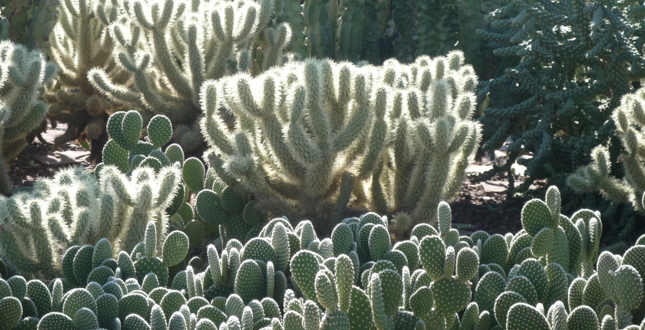 Close Me!
Close Me!The basin garden emphasizes the play of light against the forms and textures of cactus.
Download Hi-Res ImageImage: Bill Timmerman and Adam Rodriguez
Image 8 of 13
 Close Me!
Close Me!The onyx light channel breaks in the Foothill Garden, creating a paradoxical seep of water cutting into the stone.
Download Hi-Res ImageImage: Bill Timmerman and Adam Rodriguez
Image 9 of 13
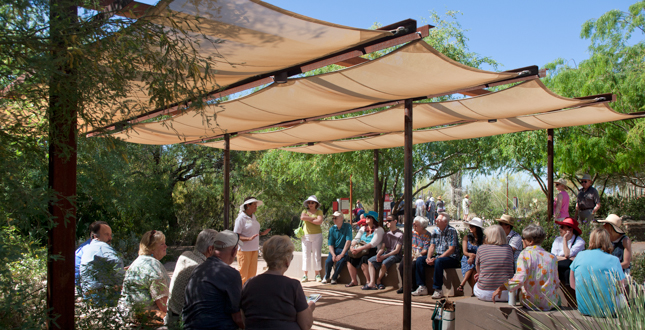 Close Me!
Close Me!A program objective of the new entry is to create a lobby that connects the visitor amenities including shaded tour gathering, cafe and garden shop.
Download Hi-Res ImageImage: Bill Timmerman and Adam Rodriguez
Image 10 of 13
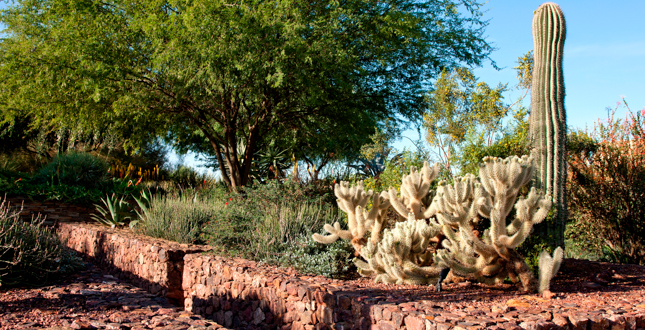 Close Me!
Close Me!The Foothill garden steps up into mid-level terraces bringing plants up to eye level. The deeper red metamorphic rock and saturated greens of desert scrub reflect the Arizona foothills of the Phoenix valley.
Download Hi-Res ImageImage: Bill Timmerman and Adam Rodriguez
Image 11 of 13
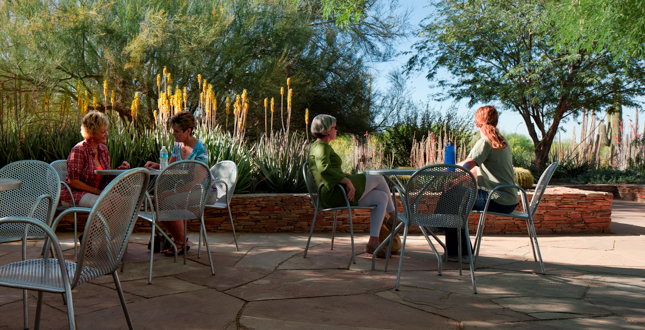 Close Me!
Close Me!The Hilltop Garden terrace, set in a grove of desert trees, offers a respite of cool shade and exotic flowering succulents. The terrace takes advantage of views over Papago Park to the distant mountains framing the Phoenix valley to the west.
Download Hi-Res ImageImage: Bill Timmerman and Adam Rodriguez
Image 12 of 13
 Close Me!
Close Me!And finally the Entry Garden creates a portal or threshold to the Core Trail of the Botanical Garden and orients visitors to a framing butte.
Download Hi-Res ImageImage: Bill Timmerman and Adam Rodriguez
Image 13 of 13
Project Statement
The Ottosen Entry Garden entices visitors into Phoenix's Desert Botanical Garden with a bewitching selection of Sonoran desert plants, staged in three distinct and remarkable terraces. A preamble to the rest of the garden, these settings frame botanica in evocative indigenous hardscape. Terraced grading and planting take opportunistic advantage of scarce rainfall. The Ottosen Entry Garden achieves the preservation of important specimens in lushly diverse contexts that delight, inform and beguile even the uninitiated audience.
Project Narrative
—2013 Professional Awards Jury
Design Intent
The landscape architect completed a new master plan for the Desert Botanical Garden (DBG) in 2008, and the Ottosen Entry Garden implements that plan's first phase. The plan called for further iteration of work initiated on DBG's entry sequence ten years ago. The new 1.6 acre, 2 million dollar project had three principal goals – to improve visitor orientation and circulation, impart the many hospitality activities of a lobby, and immediately and viscerally engage visitors with dramatic sensory enjoyment of the desert. Program elements include dedicated areas for tour gathering, special events, visitor orientation, shaded seating and improved access to amenities. Foremost, the design team strove to create a memorable, iconic space, showcasing outstanding, large specimen cacti and succulents. These sensational plants could at once provide an enhanced sense of place and whet the appetite of new and repeat visitors. The garden had to indulge the zealotry that captivates desert botanical enthusiasts. It also had to dazzle neophytes and even non-plant people.
Location
The Desert Botanical Garden is located within one of Phoenix's significant municipal attractions, Papago Park. Sensitivity to this popular and respected context was extremely important. The 80-acre DBG anthologizes the Sonoran Desert's most quintessential species as well as some of its most impressive specimens, both rendered spectacular by thoughtful placement and groupings. The Ottosen Entry Garden is an urban oasis located in the northwest corner of Papago Park among distinctive red sandstone buttes, surrounded by gently rolling acres of creosote scrub. Its north to south approach creates a dynamic backlighting that showcases the unique sculptural and textural forms of the desert plants.
Collaboration with Clients and Other Designers
Professional services included design, construction documents, construction administration and coordination of consultants including civil and electrical engineers. The landscape architect, serving as prime consultant, led a collaborative conceptual design process that included DBG donors, executive board, horticulture, research, facilities and design staff. Together the team clarified and refined the functional and aesthetic goals for the entry garden. With special consideration, the firm identified existing site features and plant specimens to preserve, relocate or showcase for maximum effect.
The goal was to create a fresh, wonderful new entry gallery, while honoring the core character of previous improvements. This consideration ensured continuity of materials and sensibility.
Design
The project's formal conception is topographic, which frames views of surrounding buttes and reflects the geography of the Phoenix basin. The Garden steps up from basin to mesa and is carved by a rectilinear grid of paths and gardens. Vistas open to iconic buttes beyond, establishing a distinctive sense of place in the larger landscape. The entry lobby is organized into three ascending gardens: The low, broad Basin Garden, open and backlit, features the largest specimen plants and the glow of spiny texture. The Canal Garden is carved into red rock walls and bisected by a linear light, which leads to a water feature, tucked away to reward the adventurous. And the Terrace Garden ascends to a small, shaded gathering space that features the more tender and colorful succulents in the collection. Each garden features its own distinctive combination of stone and plants, integrating ideas about geology and topography and highlighting the sculptural qualities of the materials against red buttes and distant desert mountains. These combine to create a unique interaction with nature that underscores the beauty and diversity of desert plants. In their distinction, the three gardens augur the rich resources visitors anticipate in the rest of the garden.
Botanical Preservation
A unique challenge and opportunity was making the most effective, judicious use of the Garden's magnificent mature specimens. Care was taken very early in the process to identify which plants were to be protected in place or removed and relocated. Similarly, the design team needed a palette and location of new plants and hardscape features to enhance but not overwhelm the setting. The expertise of the Garden's horticulture staff was an invaluable and enriching technical resource throughout the design process and installation.
Materials
Many subtle and intricate hardscape details, from masonry to metal work, showcase the high level of local craftsmanship and the project's commitment to using indigenous talent. The use of a hardscape and plant materials palette drawn from local Sonoran sources emphasizes the project and institution's integral connection to its immediate and regional context. The interplay between flora and the geology right underfoot inspired pathways and placements. Improved amenities include shaded seating, food vendors, and a beautiful place simply to sit and be.
Sustainability
DBG's preserved dry washes and soils are naturally very fast-draining. The installation includes bibs for portable “rain towers” as well as drip irrigation and bubblers for trees. Judiciously locating appropriate and reused plant material and using locally sourced and repurposed hardscape materials fulfill the goal of creating a dynamic, engagingly sustainable desert garden.
The Ottosen successfully implements a key element of the previously prepared master plan, creating a high functioning, dynamic visitor entry lobby, and fulfills the goal of emphasizing the genius loci of the Garden. Furthermore, it transforms the visitor experience into one of discovery about deserts and desert plants, the startlingly beautiful and little understood species that thrive in the harsh desert environment.
Project Resources
Design Team
Lead Designer
Andrew Spurlock, FASLA
Landscape Architect of Record
SPURLOCK POIRIER Landscape Architects
Landscape Architect
SPURLOCK POIRIER Landscape Architects:
Andrew Spurlock, FASLA
Leigh Kyle, ASLA
Andrew Brown
Brian Garrett
Ming Shiu Hung
Civil Engineer
Entellus, Inc.:
Dave Moran
Bill Linck
Lighting Design
Syska Hennesey:
Barth Ballard
Kate Thongkham
Lighting Design
TMAD Taylor and Gaines:
Jennifer Buschta
Structural Engineer
Mobayed Consulting Group:
Omar Mobayed
Irrigation
Sweeney and Associates:
Lance Sweeney
Michelle Clark
Construction Team
General Contractor and Construction Manager
RJ Bromley:
Rob Bromley
Chris Turner
Landscape Contractor
Native Resources:
Eron Dixon
Kevin Brenda
Concrete Construction
Camelback Concrete
Stone Installation
Stone Face Construction
Tree and Cactus Placement
Tempe Crane
Featured Products
Signage
Airpark Signs
Stone
All Star Material
MDI Rock
Metal Fabrication
BGB Steel
Tree & Plant Nurseries
Mazatzal Tree Farm
Mountain States Wholesale Nursery
Nowell Tree Farm
Phoenix Desert Nursery
Rancho Soledad Nursery




